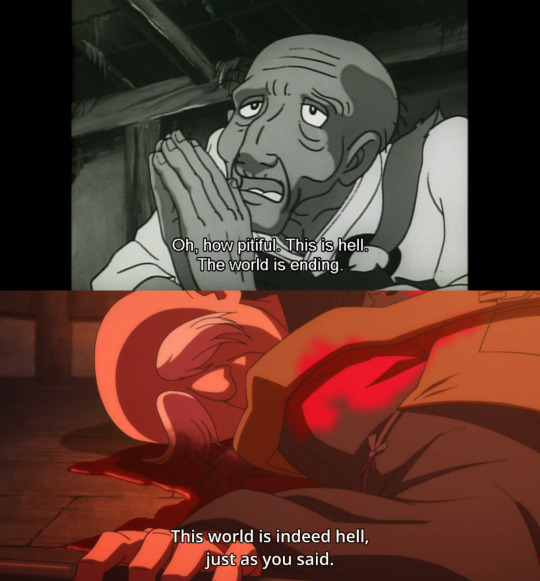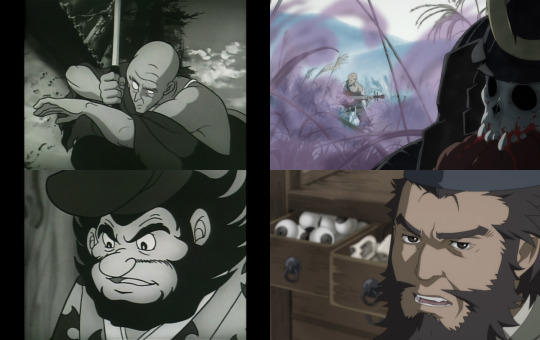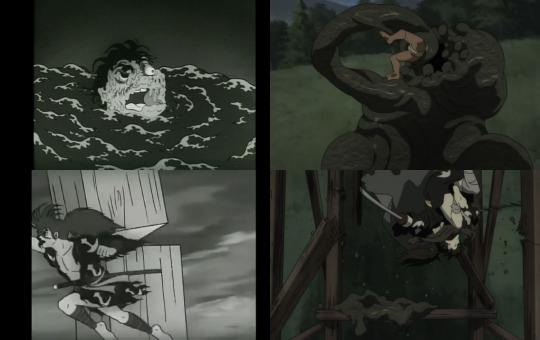#gegege no kitaro: black kitaro's ambition
Explore tagged Tumblr posts
Text
I'm sorry, but Black Kitaro's laugh sometimes sounds like that one goofy ahh laugh video.
(Sorry for the poor audio quality)
(I would like a full translation of this game in english because there aren't any English subtitles, the game is GeGeGe no Kitaro: Black Kitaro no Yabo)
#gegege no kitaro#gegege no kitaro: black kitaro no yabo#gegege no kitaro: black kitaro's ambition#goofy ahh laugh
2 notes
·
View notes
Text
50 Years of Dororo - Mushi Pro’s Dororo 1969 vs Studio Mappa’s Dororo 2019

2019 marks the 50th anniversary of Mushi Pro’s Dororo anime adaptation, the last anime to be made solely in black and white. The 1969 original Dororo anime is a cult classic, with high accolades from the diehard community and still holds up incredibly well to this day. Yet that didn't stop Studio Mappa from creating their own adaptation of the manga, which has finally released just this week. So the real question is, how do the two of them compare--well let’s get into it.
But first, a little background. The original Dororo manga, created by prolific manga creator Osamu Tezuka, ran in Weekly Shonen Sunday for about one year, from August 1967 to July 1968, where it then entered a hiatus for a brief period, before finally shifting to the Monthly Adventure King magazine in 1969 where it was serialized for about 6 months (May to October ‘69) and finally “concluded”. I say concluded but the manga mostly just abruptly stops before the characters accomplish any of their own goals, and things are more or less just left open in case Tezuka ever wanted to come back to the series (he didn't). Despite this Dororo has remained to be an incredibly beloved property by Tezuka and seen its fair share of retellings and adaptations from video games to live action films, and of course to anime.
So now let’s talk anime. The original 1969 adaptation of Dororo was created by Mushi Pro, Tezuka’s own animation studio that he started half a decade back in 1963, and as said above was the last anime to be created solely in black and white. By this point in time color TVs were finally becoming widespread in Japan, and most anime have already started to be created in color. This was not an easy process, and was more time consuming for the production, which is why the decision was made by Mushi Pro to stick to the work pipeline they had and produce Dororo in black and white, a decision that really went on to define the entire series. Mushi Pro's Dororo has a very crisp look, with some great animation for its era, but beyond that also manages some incredibly terrifying and equally breathtaking moments because of its beautiful artwork mixed with the black and white aesthetic. There’s just something about black and white, the atmosphere it creates is otherworldly, ask any movie buff and they’ll tell you the effects it has on the horror genre is undeniable. I think these late black and white 1960 era anime hold up so incredibly well, and may in fact be even creepier nowadays (the 1968 GeGeGe no Kitaro comes to mind).

Dororo (1969) episode 4: The Scroll of Bandai Part 2
Time marches on however, and after 50 years it’s time for another studio to take a swing at Dororo. Mappa is a small animation studio established in 2011, founded by Masao Maruyama, producer and co-founder of Madhouse, who left Madhouse to pursue his own passions and took some staff with him. Maruyama would later leave Mappa in 2016 unfortunately, but the studio to this day has still been producing hits since. The staff behind their current Dororo adaptation is helmed by Kazuhiro Furuhashi as director, Satoshi Iwataki as character designer, Yasuko Kobayashi in charge of scripts, and Yoshihiro Ike composing the music. Background animation is handled by Studio Pablo. Dororo is produced by Twin Engine, a production company with its main focus being the creators of the medium. Founded by Kouji Yamamoto, Twin Engine wishes to let young artist focus on creating anime, ignoring popular trends instead pursuing only the art of the medium; often commissioning work from studios to keep them financially afloat. Dororo, like a large majority of Twin Engine produced series, streams worldwide on Amazon Prime.

My final aside before diving into some thoughts on how both adaptations compare is that when it comes to adapting Tezuka’s iconic designs to the form of animation there are often changes made. The more Disney-esque look of his drawings can be hard to pull off for action animation, and well, giant noses, and bushy mustaches are well and good, but when you’re trying to sell hideous monsters chomping people into bits, maybe they are not that fitting for this story. That’s why both the 1969 Mushi Pro and 2019 Mappa series have their own takes on the design of the characters. Mushi Pro sorta goes for making protagonist Hyakkimaru more buff, and adult looking, whereas Mappa makes their Hyakkimaru slim and more ikemen. I think both approaches work fine for the story at hand, and are interesting time capsules of themselves for their own eras.
So let’s compare the first episode of both series!

Both episodes start in a similar fashion, with Feudal Lord Daigo Kagemitsu making a deal to 48 Demons and sacrificing his then unborn son in the process. However even this early on we can see differences between the two adaptations.
In the 1969 Mushi Pro version Daigo willingly offers up his own son to the demons, and does so for power, asking them to grant him all of Japan under his rule, whereas in the 2019 Mappa version Daigo only offers the demons anything they want in return, never directly giving them his own son, and asks for the demons to give him the power and prestige he will need to rule over Japan.
At first I felt that Mappa may have made Daigo a bit more sympathetic, him seemingly asking for his own province to be granted protection from disease, famine, and war is certainly something we haven’t seen out of the character, but were perks he does enjoy later in the story regardless. As I ruminated on it however, I realized it’s more of an attempt to round out his character and add some extra depth to him. Sure those may have been great things for a Feudal Lord to ask for, but Daigo really only cares about one thing, and that’s ruling Japan; this has yet to change. Daigo still has no qualms about his own son Hyakkimaru being born a hideous freak and still throws away the newborn baby to die in some river while yelling at his wife to make another one to replace it.

One Buddhist monk starves to death while bemoaning the state of Japan while another is slain and bemoans the current state of affairs in Japan
Then there’s Daigo killing a Buddhist monk. This scene does not exist in the 1969 Mushi Pro version (but Daigo does murder the monk albeit under different circumstances in the manga) and I have quite a bit to say about that. Daigo’s conversation with this monk, again, shows him off to be a bit more well rounded. He’s still selling his soul to the devil, but we can see his own level of commitment to his ambition when talking to the monk. The monk also plays another role that mirrors Mushi Pro’s first episode. In Mushi Pro’s debut episode Dororo comes across a starving Buddhist monk that can do nothing but beg for food and pray, and eventually succumbs to his starvation and dies. Both monks remark about the horrors of the current sengoku era being like Hell on Earth, and are meant to communicate to the audience that this particular time in Japanese history is perhaps one of the cruelest.

1969 or 2019, Daigo is still a dirt-bag and makes his wife suffer.
Let’s talk about Hyakkimaru’s birth as I think it’s a pretty interesting contrast between these two adaptations. In the 1969 Mushi Pro version Daigo already knows his son should be born a monster so upon seeing the hideous freak that is his baby boy, he proudly declares “My end of the bargain is fulfilled!” The demons have accepted Daigo’s offer and he can’t be happier. In the 2019 Mappa version Daigo is not aware of what the demons will take until a bolt of lighting strikes the room his wife is giving birth in. Upon seeing the baby up close (something not seen in the 1969 version until the second episode) Daigo realizes what has happened and orders the baby killed. We then get a conversation about a Buddhist statue that happened to break in the same room. The wet nurse believes it sacrificed itself in order to save the baby, giving a sorta strange implication that perhaps the deal wasn't to take 48 body parts from Hyakkimaru but to take everything from him, including his life. In fact we never really even establish if there are 48 demons, or 48 body parts missing, so the number may vary, and the kind of curse could be different. If that is true, it is certainly a unique approach to the series.

The image of baby Hyakkimaru from Mushi Pro's 1969 Dororo adaptation is taken from the second episode as it was not shown in the first episode.
Hyakkimaru’s birth between the two versions shows how both mirror each other--we have less subtle writing but more subtle animation in the 1969 Mushi Pro adaptation, and more subtle writing but super over-the-top animation in the 2019 Mappa adaptation. I find this maybe the best way to compare these two anime entirely so far. There is no huge lightning bolt smiting the room Daigo’s wife is giving birth in with the Mushi Pro version, instead you hear the mother scream in terror upon Hyakkimaru's birth as she breaks down and cries. Daigo and his wife's expressions of horror at the baby is the only clear indication of Hyakkimaru's hideousness instead of just showing the baby like Mappa did. But the Mappa version is trying to give some more depth to its characters, and maybe even to its own world with added bits such as the Buddhist statue maybe protecting Hyakkimaru. Both adaptations seems to have reverse on what they want to be subtle about and what they want to be over-the-top about.

In the 1969 Mushi Pro version Daigo and his wife send Hyakkimaru down the river in a basket themselves, where as in the 2019 Mappa version Daigo orders the wet nurse to drown Hyakkimaru in the river, but she pities the baby and places him in an abandoned boat then pushes it down the stream. And then a demon shows up and murders her out of nowhere and is slain by the blind monk Zato (a character that didn't appear until Hyakkimaru narrates his past to Dororo a little later in the story). Yeah, that was a really weird addition to the story Mappa made. It’s certainly more over-the-top and gets a bit more action into an episode that amounts to basically all set-up, so there is that, I guess. Still really weird to see Zato show up like this.

Both Zato and Jukai don't make their introduction until Hyakkimaru explains his past to Dororo in the second episode of the 1969 Mushi Pro Dororo.
Speaking of adding in characters earlier than before, Mappa included scenes that would interrupt the episode every now and again that focus on a doctor who gives prosthetics to dead maimed warriors so they can rest in peace. These scenes did not exist in the 1969 Mushi Pro version, which didn't show Jukai until episode 2 where it tells the story of how he saved a baby in the river he found, Hyakkimaru, and gave it prosthetics.

The introduction to Dororo is pretty similar in both versions, but more drawn out in the 1969 Mushi Pro adaptation. As discussed above with Daigo and the Buddhist monk, there was a scene where a starving monk begs Dororo for food before succumbing to his own starvation and dying, this was not present in the 2019 Mappa adaptation. Dororo gets more time to just do some general hijinks and mess around in town in Mushi Pro's version as well, before finally stealing food from some lowlifes and getting the crap kicked out of him by the riverbank.
In the Mappa version instead of stealing food from lowlifes Dororo steals their cargo and tries to pawn it but is caught then beaten at the riverbank. I imagine Mappa was just trying to streamline Dororo's introduction here for time constraints so they did their best to get across that he’s a thief while also making sure he ends up at the riverbank right away. Either way both adaptations lead to this slime looking monster appearing out of a pile of garbage in the river and eating the lowlife. Mappa’s more over the top animation has the monster swinging around its arms wildly until eventually grabbing said lowlife and making a snack out of him, where Mushi Pro has it slowly slither on top of the lowlife and then melts him. Ouch, that’s kinda way more messed up.

The lowlife gets melted by the monster in the manga too.
From this point on both adaptations are pretty much entirely the same, with just differences in animation quality being really all there is to comment on. The fight scene between Hyakkimaru and the slime in Mappa’s version is fantastic, with Hyakkimaru performing incredible acrobatics, jumping all around the bridge and slicing the whole thing up until it collapses on top of the slime killing it, where Mushi Pro … well they did their best, okay.

The real big difference is that Dororo seems a lot more intelligent when approaching Hyakkimaru in the 2019 Mappa version. Dororo was very quick to notice that Hyakkimaru is blind, and that his body is made up of mostly prosthetics. The 1969 Mushi Pro Dororo ends up getting terrified in the very next episode upon the realization that Hyakkimaru’s eyes are fake (he admittedly popped his glass eyes out of his head though to scare Dororo away).

The 2019 Mappa version has it that the riverbank monster was apparently one of the 48 demons Hyakkimaru needed to slay in order to regain his body parts, this one giving him back his skin. Hyakkimaru was actually born with his skin in the 1969 Mushi Pro version (as well as in the manga), and the monster was not the first demon he needed to kill but just a run-of-the-mil yokai that awarded him no regenerated body parts. Hyakkimaru actually worded it as "the dead", which have no true shape of their own and just latch onto anything, in this case the garbage in the river--thus making the slime monster we saw. Again I think Mappa was trying to kill two birds with one stone and get the audience acquainted with the series quicker since the general plot is essentially Hyakkimaru slays monster, Hyakkimaru grows back lost body part. This was a good way to streamline things, and it was with a body part that he wasn't missing before so it takes away nothing from later parts of the story.

And this is the biggest difference right here at the end of the episode, Hyakkimaru has yet to talk. He may not be able to speak at all until he’s slain enough demons to get this ability back. The Mappa version has so far seemed to point to Hyakkimaru being mute, deaf and blind, and completely cut off from the world. The Mushi Pro version had Hyakkimaru lack his eyeballs, his mouth, and his ears, but he could still speak and hear (just like in the manga). I always assumed it was just his outer ear missing but he still had all his inner ear like his eardrums, and well, you can talk without lips, so there was that too. The Mappa version seems to fully commit to Hyakkimaru being born without all his senses, and if it’s true it will be a super interesting take on the character to be sure. It will also be hard to pull off considering how much he speaks in the original story; he's a very vocal character, so if it is true, until he regains his ability to speak Dororo has to be the one to carry the duo in conversations entirely now which will lead to major shake-ups in the plot.
What do you think of the newest anime adaptation of Dororo. Are you excited to see the classic come back for modern times? Do you wish it was more like the manga or are you enjoying all these attempts to create something more modern with the source material? Do you think Hyakkimaru will speak in the next episode or do you think he's actually going to start the show as a mute? Are you looking forward to keeping up with this new adaptation of Dororo?

PS - Shout out to Mappa for putting a dog into their first episode that resembles Nota, the mascot character invented for the 1969 Mushi Pro series in a vain attempt to prevent the children that were watching it from being emotionally scarred (it probably didn't).
#Dororo#Hyakkimaru to Dororo#Hyakkimaru and Dororo#Hyakkimaru#Mushi Productions#Mushi Pro#Mappa#Studio Mappa#anime
33 notes
·
View notes